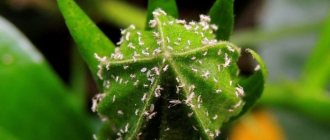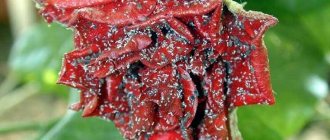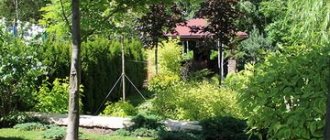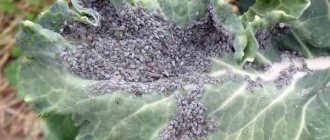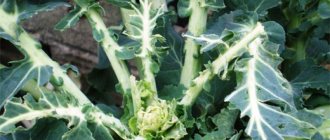7244
The damage that aphids cause to an area is not comparable to the miniature size of the insect. In order to prevent mass infection, it is necessary to follow all the rules of agricultural technology and not forget about prevention. Before fighting aphids on fruit trees, in order to prevent the formation of colonies and avoid epidemics in the garden, it is necessary to find out the reasons for the appearance of insects, and then select chemical and biological preparations, and folk remedies.
Green aphid attack
What does the pest look like?
Aphids are small insects (no more than 7 mm). It has an oval or teardrop shape. The mouth is presented in the form of a proboscis, with which it pierces the tissues of the plant and sucks out the juices from them. It comes in white, green and black. Black aphids are more common in gardens.
ON A NOTE. There are several thousand species of aphids. Interestingly, aphids are a kind of pet for ants. They milk her like people milk cows.
The danger of aphids is that they feed on tree sap, disrupting the natural processes of sap flow. As a result, some of the plant's shoots do not receive proper nutrition. The activity of aphids also affects the fruits of fruit trees.
Damage to trees and bushes
An insect, having settled on a plant, begins to master it, choosing young tender leaves and shoots for feeding. In tissues deprived of juice, photosynthesis and metabolic processes are disrupted, which affects the growth and development of the tree, the formation of buds and ovaries. Young trees, if no measures are taken, will enter winter weakened and may not withstand severe frosts.
Related article:
Laundry soap is an environmentally friendly way to combat pests and plant diseases
Aphids suck out much more juice than they need to survive, so the remainder is excreted from the body and forms a sugary coating on the leaves and branches. Honeydew (honeydew) blocks the access of oxygen to cells, interferes with photosynthesis, and creates excellent conditions for the development of fungal infections. A frequent companion of aphids is black sooty mildew, viral diseases, and gall-like formations that weaken the plant. Viruses and fungi are also carried by ants.
Why do aphids appear on trees?
There are several reasons why your garden becomes a victim of a pest:
- Insects come from neighboring areas.
- The insects have overwintered in the bark of your trees.
- The aphids were brought to the site by ants.
The danger of aphids is that they can produce up to 20 generations of parasites in just one season. The insect grows quickly and has an inordinate appetite.
Why are aphids dangerous and how do they appear?
Aphids are small insects that parasitize the shoots, leaves and flowers of fruit trees. It feeds on their juices, piercing the delicate skin of young parts of plants. It reproduces very quickly - within a month, one female reproduces hundreds of thousands of individuals. Aphids form huge colonies on the tree, which deplete its vitality: they reduce growth, productivity, frost resistance, immunity to diseases, and shorten life expectancy. They secrete a sweet liquid (the so-called honeydew), which becomes a favorable environment for the development of fungal infections. It can also attract termite ants, which will destroy the tree in a short time.
Aphids live in close symbiosis with ants, which feed on their honeydew, protect them from predators, and participate in their movement. If a colony of small pests has grown too large, the ants spread them to other plants in the garden. Often, when an ant swarm moves to a new place, it takes aphids with it. The parasitic insect is also capable of moving independently. At the height of summer, a generation of winged individuals is born. They scatter throughout the garden and lay eggs in the bark of trees and shrubs. The fight against aphids is of great importance for obtaining a full harvest of garden plants.
How to treat aphids on trees, effective preparations?
The most effective way to kill aphids is to use chemicals. They have different operating principles, but they are aimed at the complete destruction of pests on shrubs and trees. Insecticides are used in the preparation of solutions for spraying trees.
There are 3 main groups of drugs against aphids:
- System . Penetrate into plant tissue, making them poisonous to aphids;
- Contact . They kill an insect by falling on it;
- Intestinal . Poisons aphids.
In the following table you will find information about the most effective drugs against aphids and methods for preparing the working solution.
Table. Effective drugs against aphids
| Means | Preparation | Treatment frequency |
| Biotlin | 2 sachets (3 ml) per bucket of water | Apply once per season |
| Aktara | 2 grams of powder per 10 liters of water | Apply no more than 2 times only before flowering begins. Treatment interval – 1 week |
| Fury | 1 ml per bucket of water | One spray per year, no later than 30 days before harvest |
| Arrivo | Ampoule 10 l | 2 treatments 2 weeks apart |
| Karbofos | 5 grams of emulsion are diluted in 1 liter of water | 1 time per season |
| Spark | 0.5 tablets per 5 liters of water | Use until the buds swell |
| Confidor | 1 gram of powder per 5 liters of water | No more than 4 treatments at intervals of 2-3 weeks |
| BI-58 New | Ampoule for 5 liters of water | Maximum 2 treatments |
| Green soap | Mix 400 ml in 10 liters of water | As needed |
| Fufanon | 4 ml per 3 liters of water | No more than 3 treatments with an interval of at least 7 days |
| Aktellik | 10 ml per 10 liters of water | No more than 2 sprays per year |
| Fitoverm | 25 ml per 3 liters of liquid | As needed. Finish processing at least 5 days before harvesting the fruits |
| Aktofit | 80 ml per 10 liters of liquid | No more than 2 sprays |
| Arrivo | 3 ml for 2 buckets | Process no later than 3 weeks before harvest |
| Tanker | 3 ml per bucket | One treatment |
| Kinmiks | Half an ampoule for 5 liters of water | No more than 2 treatments |
| Kalash | 10 ml per 20 liters of water | The treatment interval is 21 days. Spray no more than 2 times per season |
| Commander | 5 ml per bucket | No more than 3 sprays with an interval of 2 weeks |
| Arrow | 25 grams of powder per five-liter sprayer | Biological agent. Apply at intervals of 10-15 days before fruiting. |
| Alatar | 10 ml for 2 buckets of water | One-time processing |
| Cortlis | 4-5 ml per 1 bucket of water | The consumption of the working solution is half a bucket per tree. One treatment per year |
IMPORTANT! Strictly follow the instructions on the drug packages and the manufacturers' recommendations regarding the timing and method of using the poison.
Processing terms and rules
To combat aphids throughout the year, fruit plants need to be treated 2 times: in spring and autumn. In both cases, you should follow the spraying rules:
- The event should be held in the evening, in calm, clear weather;
- use chemical solutions to combat aphids on the same day;
- alternate medications, preventing insects from “getting used” to the poison;
- follow the recommendations in the instructions on the packaging;
- before processing, remove weeds from the tree trunk;
- if there are hives, close the entrances and cover them with film;
- When treating the crown of fruit trees, make sure that a sufficient amount of the product gets on the underside of the leaves.
Spring treatment of fruit trees
In the spring, measures that will help cope with aphids are carried out at any time, except for the period of bud break and flowering. This is because many chemicals are toxic to bees. By processing trees at this stage, you can be left without pollinators, which will inevitably affect the harvest. The fight against aphids should begin by removing insulation from the trunks and whitewashing fruit crops with lime mortar (2 kg of lime per 10 liters of water). You can purchase special compositions for this purpose - acrylic whitewash or lime pastes with the addition of copper sulfate. Spraying with a solution of diesel fuel diluted with water 1x1 creates an oily film, under which the eggs and larvae of aphids suffocate for several hours.
Warning! Spraying is done from top to bottom: first the crown of the tree, then the branches, trunk and soil around it.
Autumn treatment against aphids
Preparing fruit plants for winter is an important step in a gardener’s work. Autumn measures to combat aphids are aimed at maintaining plant health and getting a good harvest next year. Care must be taken to ensure that fruit trees survive the cold comfortably and are protected from pests. Necessary actions aimed at combating aphids:
- remove fallen leaves and fruits;
- dig up the soil around the tree;
- clean off dead bark;
- whitewash the trunk with a lime mixture with the addition of an insecticide;
- spray with any of the means suggested above;
Protective procedures against aphids on fruit trees should be carried out in late October - early November. The start of work should coincide with the period of active leaf shedding.
How to treat plum and fruit trees
The plum aphid is the most dangerous species of the entire large family. She eats not only plums, but also all stone fruits, except cherries. Prevent the reproduction of aphids on fruit crops by potassium fertilizing (3 tablespoons per 10 liters of water), regular weeding, spraying with diesel fuel, Isofen, DNOC, Karbofos, Nitrophen, Oleocuprite before winter. It is necessary to treat not only the fruit tree, but also the soil underneath it against aphids.
What are the dangers of chemical treatment?
Despite all their effectiveness, chemicals have several significant disadvantages that make their use dangerous. Let's consider the most significant of them.
- Poisoning. When working with poisons, you can get minor poisoning. This is especially true for those summer residents who neglect protective equipment.
- Harm to plants. Incorrect dosage may cause chemical burns.
- Nitrates in fruits. Do not get overly involved in treating with pesticides. Some of them, when decomposed, leave nitrates in the fruits.
- In addition, treatment with chemicals during flowering can cause the death of bees. Most poisons are non-selective, meaning they are dangerous to all insects, beneficial and pests. Treatment with such compounds during periods of abundant flowering leads to damage to all agriculture, and especially to beekeeping.
How to fight aphids on trees using traditional methods
You can also fight aphids using traditional methods. Most of them compare favorably with chemical preparations in that they are safe for fruits, plants, bees and people. However, you need to understand that the effectiveness of folk remedies is often much lower than that of poisons. This means that in case of large-scale infestation of trees with aphids, such methods will not help.
ON A NOTE. Using folk remedies, it is better to carry out several treatments with an interval of 3 days.
Ammonia
Pour a bottle of ammonia into a bucket of water. Mix, pour the product into a sprayer and treat the trees.
ON A NOTE. Ammonia evaporates quickly, so it is better to work with small young trees with this solution.
Tobacco dust
It can be used in 2 ways. First, prepare an infusion and spray the trees with it. The second is to poison the aphids with tobacco smoke. To do this, light a small fire in a bucket, and then put it out by pouring out a bag of tobacco dust. Next, you need to stand downwind so that the smoke goes to the infected plants.
Infusion of celandine
Finely chop this herb, add water and leave for 3 days. After this, strain the liquid, dilute it with clean water and add grated soap to make the solution stick.
Onion peel infusion
Pour water over the husk and leave for 2 days. Strain the liquid, mix with clean water and add grated soap. Spray the infected plants with the resulting solution.
Mustard powder
Sprinkle the product under infected trees. The second method is to prepare a spray solution. To do this, mix 50 grams of powder with 5 liters of water. Treat the plants.
Garlic infusion
In a quart jar, soak 3 cloves of finely chopped or crushed garlic. Leave in the refrigerator for 24 hours. Then strain and pour the resulting mixture into a sprayer. Treat infected trees.
Tar soap
You need to rub 50 grams of tar soap onto a five-liter sprayer. Small trees can even be washed with this solution.
Ash and garlic solution
Finely grate 2 garlic cloves and cover them with hot water. Then, stirring, add 100 grams of ash. Strain the solution and pour into a sprayer. The product is ready for use.
Iodine and whey solution
The treatment solution is prepared from 5 liters of water, 500 ml of whey and 0.5 teaspoon of iodine.
Kerosene
The aphid repellent is prepared as follows: rub a bar of laundry soap into a bucket of warm water. Then add 5 ml of kerosene to the mixture.
Metronidazole
The product can be bought at a pharmacy. The spray solution is prepared from 20 crushed Metronidazole tablets and a bucket of water.
Trichopolum
This drug is also sold in pharmacies. The product for treating infected trees is prepared as follows: 20 tablets are finely crushed in a mortar and filled with a bucket of water. Everything is thoroughly mixed until completely dissolved.
Control measures
Peak reproduction of the insect occurs at the beginning of summer, so June is the month of pest control in many garden areas. You can destroy aphids on fruit trees using special preparations, as well as using simple folk methods. Let's take a closer look at both of these types.
Drugs
Contact
This category of chemicals affects aphids by direct contact with their body. Many gardeners choose this particular type of preparation, because of all the “chemicals” they are the most harmless. To combat aphids that have settled on garden fruit crops, it is recommended to use the following means:
- Fufanon (it will also be useful to learn about how to use fufanon against weevils on strawberries);
Fufanon - Fury;
- Karbofos (it will also be useful to learn about how strawberries are treated with karbofos in the spring).
Intestinal
The effect of these drugs is based on their ingestion by aphids. Essentially, the substances poison the insect’s body from the inside, after which the aphid dies. The following drugs in this category are recommended:
- Confidor;
Confidor - Aktellik;
- Bankol.
System
These are the most effective chemicals, but they are also the most aggressive and dangerous. Systemic agents should not be used during the period of flowering, ovary formation and fruiting. It is possible only before flowering in the spring.
Note that these products are able to penetrate deeply into plant tissue and stay there for about 30 days. The result of spraying will not appear immediately, but after two weeks - you need to be patient.
The following systemic category drugs are especially effective in controlling aphids:
- Biotlin;
Biotlin - Tanrek (by following the link you can learn more about the remedy for the Colorado potato beetle Tanrek);
- Aktara;
- Prestige.
Prestige from aphids
To prevent the appearance of aphids on fruit trees, even before new buds appear, it is recommended to spray the plants with a preparation such as C-30. This product can destroy the larvae and eggs of the pest.
Traditional methods
Products in this category are considered safe because they are prepared from natural ingredients. Therefore, homemade medicines can be used for spraying fruit crops during their flowering and fruiting period: there will be no harm.
However, compared to “chemistry”, natural remedies have lower efficiency, so they are recommended only when the aphid colony is still small. Let's find out the most commonly used recipes.
The video shows traditional methods of fighting aphids:
Tobacco processing
To fumigate trees with tobacco, you need to purchase tobacco dust. This is a natural insecticide that has a detrimental effect on aphids, as well as some other pests: moths, thrips, slugs, midges. To properly apply the substance, you need to set fire to wood chips in a metal bucket and pour tobacco dust onto the resulting flame. The dust must be directed in such a way that the wind blows it into the trees.
Infusion of celandine
To prepare an infusion for subsequent spraying, you need to pour celandine, potato and tomato tops in equal quantities with water.
It is necessary to infuse the product for at least three days until an unpleasant characteristic odor begins to emanate from it. Before spraying, dissolve 40 grams of soap in the resulting infusion and strain. It will also be useful to learn about how celandine infusion is used against aphids.
Onion peel infusion
As you know, aphids really do not like strong-smelling plants, including onions.
That is why spraying trees with onion peel infusion can be effective in combating the pest, and besides, it is a completely safe remedy. To prepare the desired solution, you need to steep onion peels in water for two days. After this, the product is filtered and a concentrated solution of laundry soap is added to it.
Kerosene method
A solution of kerosene (70 g) and soap (35 g) in a bucket of water (10 l) can be sprayed on fruit crops, but only before the buds open. The solution effectively destroys insect larvae and eggs, not only aphids, but also other pests.
Dandelion decoction
Aphids do not like the pungent smell of dandelion, so a decoction of the stems and leaves of this plant can be used to drive the pest away from trees.
It’s simple to prepare the product: you need to take 150 grams of dandelion leaves or stems, add a liter of water, and boil for 15 minutes. Then the product is diluted with ten liters of water and used to treat trees.
Nettle tincture
To prepare this remedy, you need to pour half a kilo of fresh green nettle (without seeds) with five liters of water: leave for five days. Strain the finished product and use it for spraying. In addition, nettle infusion can be used to treat tree trunks to repel aphids.
So, we have considered measures to combat aphids that have settled on fruit trees. As you can see, this insect, despite its miniature size, poses a real danger even to huge fruit crops. It is advisable to combat aphids at the earliest stages, and even better, to carry out preventive measures in advance, preventing trees from being affected by this pest in principle.
How to get rid of aphids if fruits have already appeared?
The best solution would be to use folk remedies and biological products. Among the most popular remedies for aphids are Strela, Fufanon, Fitoverm.
If the tree begins to bear fruit, then it is quite possible to use insecticides. But it is important to complete processing at least two weeks before harvest.
You can also use catching belts and sticky fly tape, but this is not a very effective method.
ON A NOTE. Ladybug will also help in the fight against aphids. To attract it, plant calendula, borage, cornflowers, tansy and dandelions around the trees.
Methods for controlling aphids
The fight against aphids on fruit trees should be carried out in various ways and means, which must be alternated throughout the season. There are several basic methods:
- Mechanical - allowing to reduce the number of aphids when there are few of them: pests are removed from young shoots by hand or thrown off with a strong stream of water; it is better to simply pinch off heavily affected tops and burn them.
- Biological - planting plants around trees (nettles, spicy herbs with a pungent odor) that attract insects that feed on aphids: ladybugs, lacewings, hoverflies, wasps. Some species of birds also like to feast on insects: sparrows, linnets, tits and warblers, for which feeders, drinking bowls and birdhouses are installed in the garden. To ensure that there are fewer pests on trees and shrubs, plants whose smell they cannot tolerate are planted nearby: onions and garlic, chamomile, marigolds, mint, fennel, coriander.
- Traditional methods of controlling small insects include the use of various substances and liquids that need to be used to treat trees against aphids to destroy them.
- Chemical means of controlling aphids containing pesticides are highly effective and destructive to insects; they are best used in the spring so as not to harm the ovaries and fruits.
Insect control methods
Preventing aphids from appearing on trees
First, carry out early spring preventative treatment. Weeding in the garden will help prevent the appearance of aphids.
Secondly, conduct regular inspections of branches and leaves. If you detect the first pests in time, it will be much easier to destroy them than to fight an entire colony of aphids.
Thirdly, remove anthills from the area. Especially if they are located near fruit trees.
Fourthly, do not forget about timely feeding and watering of trees.
Fifthly, in the fall and spring, whitewash the trees with lime or garden paint. It is also important to keep the tree trunk area clean so that fallen leaves, rotten fruits and broken branches do not accumulate there.
Sixthly, do not forget to carry out sanitary pruning of trees.
Types of aphids on fruit trees - where to start?
There are two types of aphids:
- Aphids with wings: they fall on vegetation by the wind that carries them, even 30 km from their original habitat. This aphid lays eggs in winter.
- Wingless aphid. Lays eggs in summer and spring.
To find out about aphid attacks, you should carefully examine the plants. Signs of its invasion may include:- The presence of small spots of dark color, which upon closer inspection turn out to be aphids. As a rule, they are located on young shoots or buds.
Leaves and buds are covered with a sticky substance.3. The affected parts of the plant curl and dry out.4. Buds that are affected by aphids do not open and die.
Aphids are especially sensitive to fruit trees because, unlike vegetables, they can easily survive the entire winter. The most important method of controlling aphids is to prevent them from infecting trees. To do this, it is important to destroy already affected branches and foliage. In the autumn, you need to carefully examine the trees for eggs laid, and if you find them, be sure to destroy them and spray the shoots with hot water (the temperature should be about 80 degrees).
Common mistakes
Let's look at the most common mistakes that gardeners make when fighting pests:
- Treatment during flowering leads to the death of bees.
- Treatment on the eve of harvest. You need to finish spraying with all insecticides within 2 weeks to avoid poisoning.
- No preventative work is carried out. Preventing the appearance of a parasite is much easier than getting rid of it later.
- One-time processing. Most likely, a single spray will not kill all the aphids. Usually 2-3 treatments with drugs of different effects help.
- The concentration of the active substance is exceeded. It is necessary to strictly follow the recommendations of the insecticide manufacturer so as not to harm the plant.
- Processing is carried out only on the upper part of the sheet plate. During spraying, the leaves need to be unfolded, the branches and the underside of the leaf blades must be treated.
Features of aphids and signs of their appearance
A common feature of all varieties is their small size - the largest individual does not exceed 7 mm. The main source of nutrition is plant sap, which the insect receives with the help of its proboscis, piercing a leaf, stem, or petal. It owes its vitality to its existence in two forms - wingless and winged.
Related article:
Treatment of raspberries in spring against diseases and pests
The wingless form is first the larvae that hatch from overwintered eggs, and the wingless females that emerge after molting. One such female lays hundreds of thousands of eggs over the course of a month. When the shoots become lignified (June-July), the time comes for winged females to settle on intermediate plants or host plants. Over the summer, more than one generation of wingless and winged females will appear on them. In the fall, winged males are born and fly to the host plant, where fertilization of the eggs laid by flying females occurs.
Reproduction and migration occur at a rapid pace, so it is important to begin eliminating the insect in time to break this chain. The population size can be significantly reduced by spring treatment, during the summer of winged females (June-July), and during the appearance of males (early autumn).
Aphids give preference to young, succulent leaves and shoots; they cannot pierce tough tissue on old ones. Some species live on vegetable and flower crops in the summer, and in the fall they move to garden bushes and trees and begin to prepare for winter. The most common fruit trees affected are plum, cherry, pear, and apple.
Related article:
Fighting moles on the site
Signs of damage:
- deformed, yellowed, twisted, dried and fallen leaf plates and shoots;
- sticky coating (honeydew), similar to sugar syrup, on all parts of the plant;
- undeveloped and fallen buds, ovaries;
- presence of gall formations;
- a large number of active ants that feed on sweet syrup and are carriers of aphids;
- On the back side of the leaf, in the leaf axils, insect colonies and accumulations of shed skin are visible.
Where aphids appear, a black ant often settles, for which sweet honeydew serves as food. Such a neighborhood is beneficial to insects - ants protect and preserve their settlements. To destroy the community, the fight against aphids and ants begins simultaneously.
Answers to popular questions
How to quickly get rid of aphids?
It will not be possible to defeat the pest instantly. The sooner you start the fight, the greater the chances of success.
Which drug is the most effective?
Aktara, Biotlin and infusion of garlic with ammonia perform well.
How often should treatments be carried out?
Using traditional methods, on average once every 3 days. The frequency of insecticide treatments varies depending on the product.
